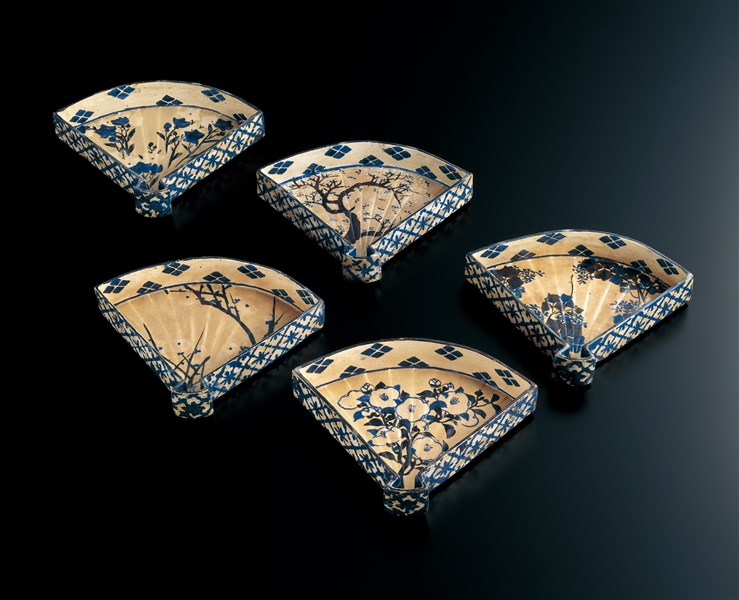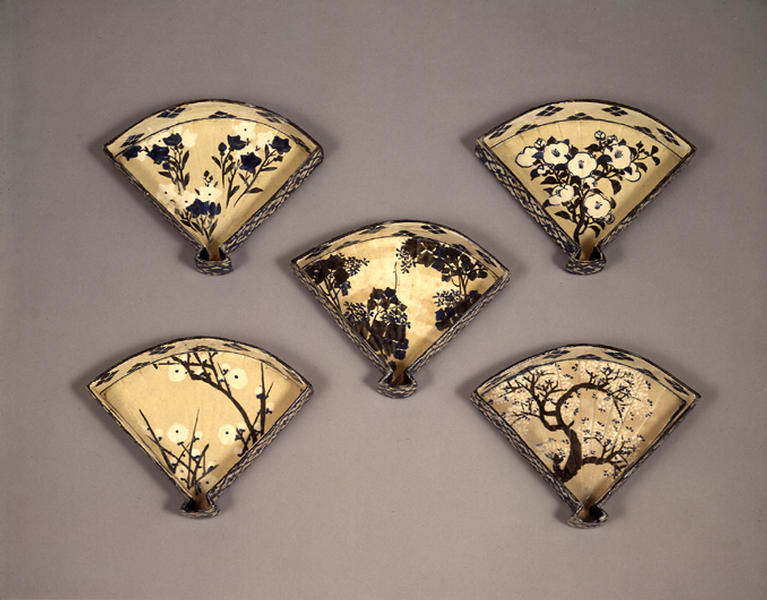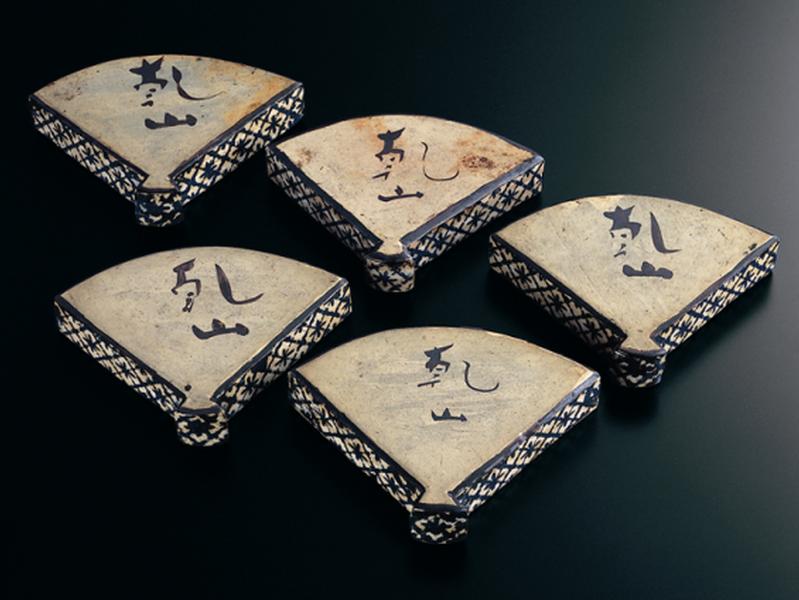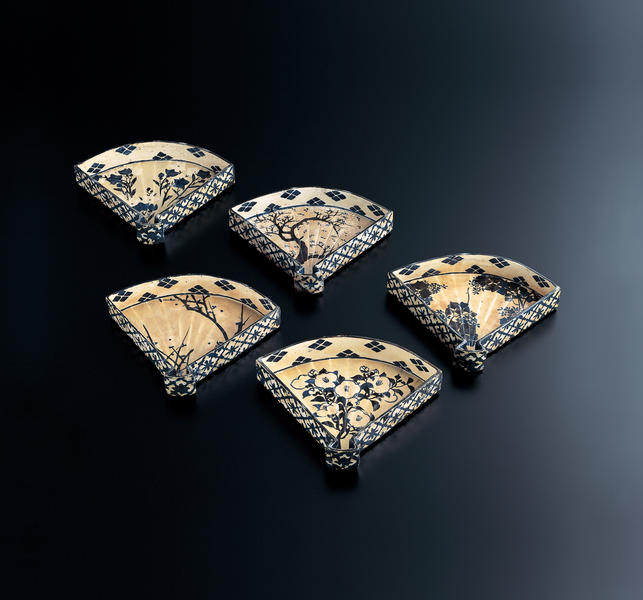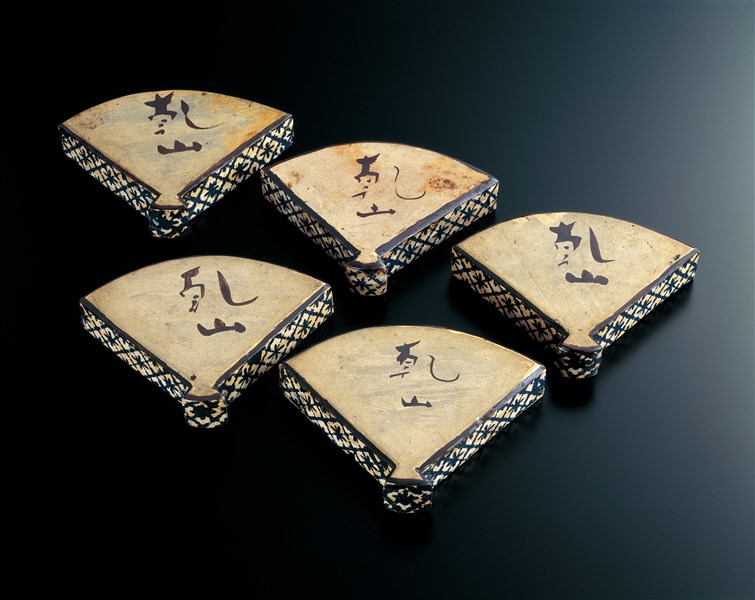乾山銹絵染付絵替扇形向付
- 江戸時代
- 18世紀
尾形乾山
尾形乾山(おがたけんざん 1663~1743)
乾山は、寛文3年(1663)京都の富裕な呉服商尾形宗謙(おがたそうけん)の三男として生まれました。兄は画家の光琳です。二人の性格は対象的で、光琳が派手好みであったのに対し乾山は内省的、隠遁的な性格の持主であったといわれています。
野々村仁清に陶芸を学んだ乾山は、元禄12年(1699)37歳のとき京都市の鳴滝に開窯しました。そして正徳2年(1712)50歳の乾山は、京市内の二条丁子屋町に移住し、多くの作品を手がけ「乾山焼」として世にもてはやされました。鳴滝時代の末期からこの丁子屋町時代にかけて兄の光琳は絵付で乾山を助け、兄弟合作の作品が数多く残されています。
享保16年(1731)69歳の頃に江戸に下り寛永寺(かんえいじ)領入谷(いりや)に窯を築いて晩年を送りました。そして81歳で没するまで江戸に在住し陶器や絵画の制作に手腕を発揮しました。
乾山の作品は陶芸作品のみならず書や絵画においても、俗気を脱したおおらかで文人的な洒脱味があります。陶芸作品においては成形、施釉、焼成は他の専門的な陶工に任せたり、絵付についても光琳との合作以外に複数の専門画家が携わっていたと思われるなど、基本的には工房生産という態勢をとっていたようです。しかし、乾山の指導のもとにつくられたやきものには、その大胆なデザイン感覚とともに乾山特有の芸術性が溢れ、乾山その人とふれあうような親しみが感じられるのです。
乾山銹絵染付掻落絵替汁次
乾山銹絵染付梅波文蓋物
乾山立鶴図黒茶碗
乾山銹絵染付桔梗図筒向付
乾山銹絵染付草文四方鉢
乾山銹絵染付松図茶碗
乾山色絵短冊皿
乾山銹絵絵替長平皿
乾山色絵寿字輪花向付
乾山銹絵絵替四方皿
乾山銹絵染付絵替筒向付
乾山銹絵染付松図茶碗
乾山色絵椿文向付
乾山銹絵染付春草図茶碗
乾山銹絵染付藤図向付
乾山色絵立葵図向付
乾山色絵雪杉図向付
乾山色絵桔梗文盃台
乾山銹絵馬図香合
乾山銹絵掻落雲唐草文大鉢
乾山銹絵草花波文水指
乾山銹絵染付絵替土器皿
乾山色絵槍梅図茶碗
乾山黒楽梅図茶碗
乾山銹絵染付芙蓉図茶碗
銹絵掻落牡丹唐草文香合
撫子図(尾形乾山筆)
乾山色絵和歌陶板
乾山色絵竜田川図向付
乾山銹絵牡丹画角皿 尾形光琳画
乾山銹絵百合形向付
乾山銹絵松文香合
乾山色絵阿蘭陀写市松文猪口
乾山色絵薄図蓋茶碗
乾山銹絵菊図水指
鶴亀図黒茶碗
紅葉図 尾形乾山筆
三十六歌仙絵/在原業平像 尾形乾山筆
三十六歌仙絵/斎宮女御像 尾形乾山筆
乾山色絵菊文手付汁次
三十六歌仙絵/小野小町像 尾形乾山筆
乾山銹絵染付山水図茶碗
銹絵染付絵替扇形向付 美し 乾山 図録解説
銹絵染付絵替扇形向付 美し 乾山 図録解説
銹絵染付の本焼製品の中でも色絵を思わせる艶(あで)やかさをもつ向付です。箱蓋表書に「乾山扇向附十枚」とあり、現在五客となっていますが、これも当初は十客揃いの製品であったことがわかります。
扇形というのも手が込んでいます。タタラ造りで扇を形づくり、よく見ると見込みには檜扇風に段をつけて型造りされています。表面にそれぞれ幹枝を銹絵で、花を染付と白泥で絵付けし、内の側面には遠菱(とおびし)と呼ばれる四ツ菱文が染付で散らされています。そして、口縁と面取された底縁に銹絵で口紅を施し、外の側面には白泥を帯状の巻雲風に引いて、その上から染付で意匠化された唐花菱(からはなびし)(花襷四葉、業平菱)文を型摺りしています。
ここに見る二種類の菱文様は、明らかに公家好みの意匠といえ、注文なのか積極的な顧客開拓なのかわかりませんが、乾山の有職故実に精通した一面が感じられます。透明釉を掛けて本焼し、底は土見せとなって、そこには銹絵で乾山銘が記されています。
乾山銘には文字性が残されており、その書風も三手に分かれます。目の細かい白土系の素地が堅く焼き締まっているのが見てとれます。いまだ絵画性を残す絵付けに文字性を留める乾山銘などを考えると、鳴滝窯時代にまで遡ってその制作時期を置いてもよいのではないかとも思われる向付です。梅、桜、桔梗、紫陽花、椿(山茶花か)と四季折々の花が描かれ、染付の青さがひときわ華やいだ明るい雰囲気を醸し出しています。
Fan-shaped Mukozuke Dishes with Various Designs
Fan-shaped Mukozuke Dishes with Various Designs
Some underglaze iron and cobalt works have the luster of overglaze enamels. This set has "10 Kenzan fan-shaped mukozuke dishes" written on the outside of the lid of its box; thus, while five now survive, there were originally ten pieces in this set.
The fan shape is complex. The fans are slab built. Look closely and you will see that the inside has been mold formed to add ridges at the bottom, where the folds in the fan paper would be. On the surface of each dish, the trunks and branches of the trees are rendered in underglaze iron and the flowers in underglaze cobalt and white pigment. The inner edge has a scattering of the diamond pattern known as tobishi, groups of four diamonds some distance apart, in underglaze cobalt. The rim and the beveled lower edge are edged in underglaze iron. The exterior surface has bands of what seem to be cirrus clouds drawn in white pigment, and, above them, stylized floral patterns (Narihira diamonds) block printed in underglaze cobalt.
These two types of diamond patterns are clearly in the aristocratic taste. Were these dishes commissioned or an attempt to develop new customers? We do not know, but we can sense Kenzan’s knowledge of usages and practices of the imperial court and in the higher reaches of samurai society. The dishes were covered in transparent glaze and fired, leaving the base unglazed. The Kenzan signature is inscribed there in underglaze iron.
The Kenzan signatures are highly calligraphic, and their style indicates they were written by three different hands. The fine white clay body has been, we can seen, fired so that it has vitrified. Given the calligraphic Kenzan signature on wares with painterly decoration, one is inclined to assign these mukozuke to his Narutaki period. The flowers of the four seasons - plum, cherry, bellflower, hydrangea, camellia (or perhaps sasanqua) - are depicted. The blue of the underglaze cobalt creates a bright, vivid atmosphere.
